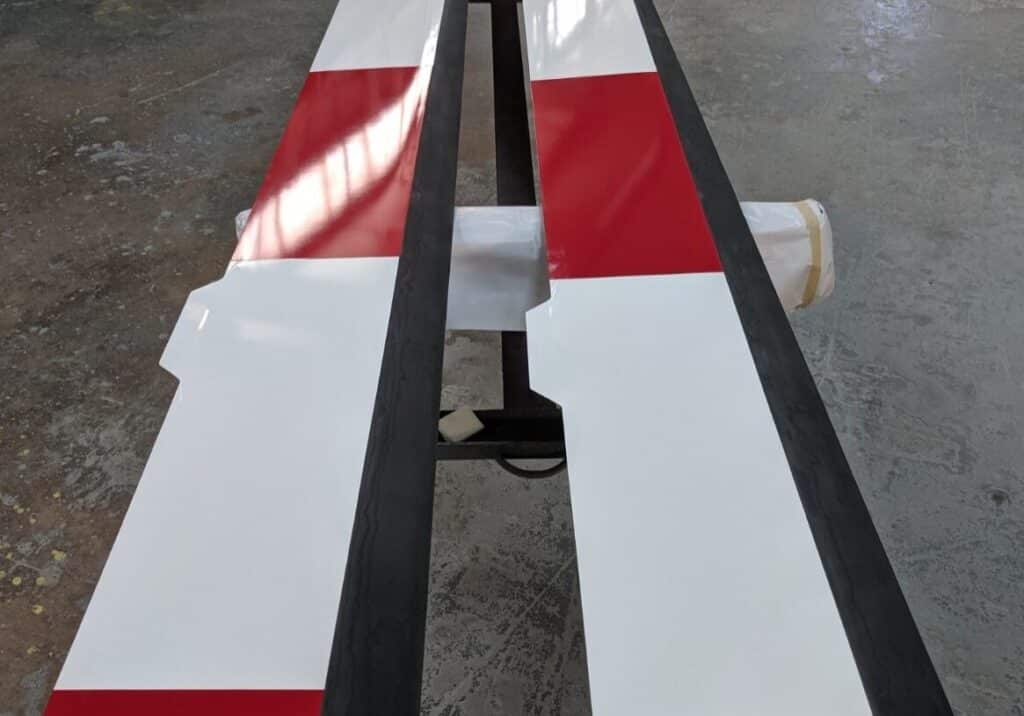
Rotorcraft’s Dragon Skin Xtreme coating is a premium way to advance blade protection. Photo: Rotorcraft Repair and Manufacturing
Written for Insight Magazine – Heli-Expo 2024
The rotor blades on a brand-new helicopter are clean and pristine, with an optimized lift-generating airfoil that perfectly slices through the air.
Put that aircraft into service on agricultural, fire-fighting, or military missions, and the blades will quickly show the effect of flying in a harsh environment.
“The leading edge of the blade becomes beat up and eroded, and then you no longer have a nice, beautiful airfoil,” explained Seth Hardage, owner of Rotorcraft Repair and Manufacturing, from its facility in Pocohontas, Arkansas.
“It affects how the helicopter will fly – it will no longer fly nice and smooth, it makes the blades not track as well, and over time it’s putting extra stress on the engine, so you’re also using more fuel.”
With decades of experience in overhaul and repair of rotor blades, to address the problem Rotorcraft has quietly developed an advanced blade erosion and corrosion protection coating.
Rotorcraft’s proprietary Dragon Skin Xtreme – DSX – underwent six years of rigorous testing before receiving FAA approvals in 2012. Since then, in a careful rollout, Rotorcraft has made DSX available to a select group of customers.
“We needed to let it go out and fly. We didn’t want to tell a lot of people about it until we knew it could last many, many hours,” said Hardage.
And in this extended field test, DSX has exceeded his expectations.
“We’ve seen more than 3,000 hours of hard flying on a helicopter, and while DSX does wear, it wears so evenly that it always keeps a perfect airfoil. It’s very rare to have a coated blade come back. We’ve only seen them return with some type of damage elsewhere on the blade,” Hardage said.
“We’ve had a couple of customers where the blade is flown out of its life limit, and I’ve bought the blade back so I could see how the coating did over all that time.”
According to Hardage, DSX can be easily applied during the time that a blade is in his shop for overhaul.
“There are a few extra steps we have to take, but not anything major.”
Decades of Experience
Rotorcraft overhauls or repairs an average of 350 blades per year, ranging from the vintage wooden blades on a classic Bell 47 to the massive rotors from a Boeing Chinook.
With a mix of work – 60% on metal blades and 40% on composite ones – Rotorcraft’s bread-and-butter is rotors from Airbus and Bell light and medium helicopters.
When a blade comes in the door, Hardage and his team get to work, first with an extensive preliminary inspection.
“I’m very eager to get the paint and finish removed because it can hide a lot of problems. I spend a lot of time looking at the blade’s structure, a lot of time trying to understand what the blade is going through, and I keep in mind what this blade is doing for a living, what they’re doing with this aircraft,” Hardage said.
“I know what to look for.”
As part of its repair process, the company can perform a full range of non-destructive blade inspections, including x-ray, borescope and eddy current testing.
If required, Rotorcraft draws on its in-house engineering team to develop repair processes and procedures to submit for FAA approval.
But it’s the company’s institutional knowledge that gives it an advantage in its operations, going back to the original owners – the Propst brothers.
Having operated Bell 47s for crop dusting and forestry work, the three brothers realized a huge time savings by doing their own blade work, rather than having to ship the blades out for repair.
“If they had to pull the blades off, then their helicopter was down, and it could take months and months to get the blades done. So, in 1992, they opened their own blade repair station in Black Rock, Arkansas.”
Drawing on relationships with original engineers from Bell – including William Underhill and Herb Waldrup, the men who developed Bell main rotor blades – Rotorcraft gained much of its knowledge and experience.
That benefited Hardage when he began working with the Propst brothers in 2018, which led to his purchase of Rotorcraft in 2020, and a move in 2021 to a 40,000-square-foot (3,716-suqare-meter) building in Pocohontas, where he and his family have their roots.
A Personal Connection
Rotorcraft’s success has been driven by its relationships with its customers, and word-of-mouth recommendations continue to bring new business to the company.
“When someone calls, I want to get to know them. They’re putting a lot of trust in me. I’m going to be working on something where lives are on the line.”
It’s important for Hardage to maintain those strong relationships, which he does with visits to his clients.
“I understand we’ve got these new technologies, but face-to-face and a good ‘ol handshake goes so much further.”